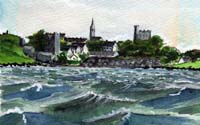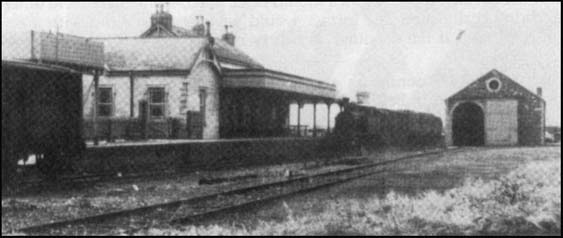|
|
Ardglass.County Down. |
|
| |
Ardglass. |
|||||||
Ardglass was a town of Ardglass and surrounding area was in Gaelic times controlled by the Magennis Clan. After the Norman invasion the Ards peninsular came under the control of the Savage family, who when they had become sufficiently established attempted to oust the Magennis and other Irish families, they turned to The Earl of Kildare for assistance, promising him one or two townland's, Kildare marched his forces as far as Ballykinlar when the Savages submitted. This was a fortuitous occasion for Kildare who took control of all of Lecale. It was from the Kildare family that Bernard Ward bought five townlands in the late 1500's which were to become the Castle Ward Estate. Situated on a hill overlooking the harbour is Kings Castle There are many historic buildings the chief of which is arguably Jordan's castle described below. Jordan's castle situated in the village of Ardglass
between Kildare street Francis Joseph Bigger bought the castle in 1911, he restored and furnished it, in 1926 he bequeathed it to the state. The figures on the third floor are modern copies of 14th century originals. Jordan's castle held out from 1598 to 1601 against the forces of the Earl of Tyrone (Hugh O'Neill) in rebellion against Queen Elizabeth I. After the plantation much of the area around Ardglass came under the control of the Ward Family of Castleward House, near the village of Strangford The Ward's developed the nearby town of Killough (Church on the Lough) as a port building stone quays on each side of the harbour entrances. In 1790 Lord Charles Fitzgerald remodeled the old castle which stood near the quay at Ardglass, converting it into a dwelling. He also converted a range of buildings belonging to the castle into stores, the castle is now occupied by Ardglass Golf Club, and some of the stores are used by the harbour authority. In the 1800's the town came under the control of William Oglivy, during his period of stewardship the town seen many new buildings erected. The town eventually became a centre of the herring fishing, which brought not only boats from many ports in the UK and Ireland, but also teams of women who gutted the herrings and packed them into barrels of brine for export. Often romances sprung up and some of these women never left the town, marrying locals and rearing families, giving the village a cosmopolitan outlook and a tolerance of others and their point of view which is sadly lacking in some of the larger towns in Ulster. Today the town's main industry is fishing and Ardglass has been an important fishing port since earlier times, read about fishing in Ardglass from Samuel Lewis' Topographical Directory of Ireland published in 1837 A branch line from Downpatrick came to the town in 1892, in the picture above you will notice the railway lines which ran from the station on the Downpatrick road along Bath street to the harbour.
|
|||||||
Go
to County Down Parishes page. |
|



 and Quay street
is a 15th century tower house it is the largest of a group in the area,
testifying to the importance of Ardglass as a town and port in the middle
ages. The entrance is protected by a small machicolation at right angles
to the main arch. The west tower contains a spiral staircase and the east
tower has latrines at two levels. The ground floor roof is barrel vaulted.
There are three chambers above with modern wood ceilings.
and Quay street
is a 15th century tower house it is the largest of a group in the area,
testifying to the importance of Ardglass as a town and port in the middle
ages. The entrance is protected by a small machicolation at right angles
to the main arch. The west tower contains a spiral staircase and the east
tower has latrines at two levels. The ground floor roof is barrel vaulted.
There are three chambers above with modern wood ceilings. fish processing with a
fleet of about twenty trawlers landing mainly prawns, a few smaller boats
fish for crabs and lobster in season. The harbour is administered by the
NIFHA (Northern Ireland Fisheries Harbour Authority) the authority built
a fish market and ice plant at Ardglass, repeated requests from the local
fishermen for a boat slip met with no success, local boats have to go
to Kilkeel or Portavogie for repairs, taking much needed potential revenue
outside the community.
fish processing with a
fleet of about twenty trawlers landing mainly prawns, a few smaller boats
fish for crabs and lobster in season. The harbour is administered by the
NIFHA (Northern Ireland Fisheries Harbour Authority) the authority built
a fish market and ice plant at Ardglass, repeated requests from the local
fishermen for a boat slip met with no success, local boats have to go
to Kilkeel or Portavogie for repairs, taking much needed potential revenue
outside the community.